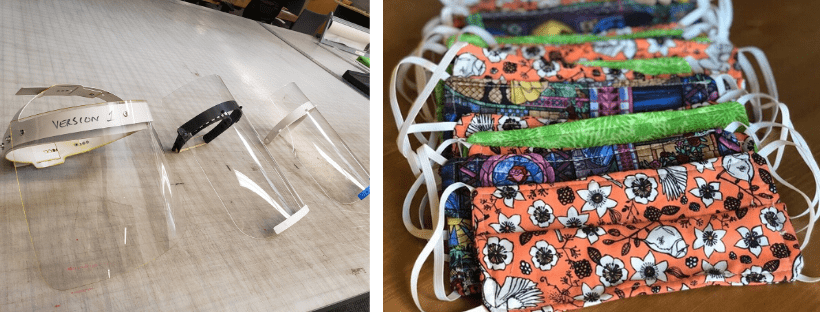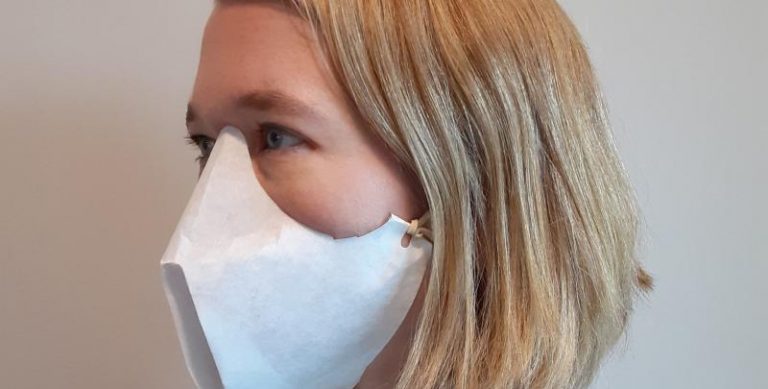Open Source PPE during the COVID-19 Crisis
by Matt Bell
November 1, 2020
by Matt Bell
November 1, 2020
On Thursday, March 26th we invited participants to listen in and inquire, as we sat down with Dr. Evan Malone, founder and president of NextFab, during our first NextFab Webinar. Evan and team are immersed in Philadelphia’s efforts to supply open source PPE resources for the medical industry during the COVID-19 crisis.
Evan’s background in engineering, 3D printing, and materials science range to form a diverse career, ranging from developing technology for laboratory settings, to creating potential 3D Printing applications in space exploration. In 2009, he founded NextFab, Philadelphia’s makerspace network. In light of the current COVID-19 crisis, the Pennsylvania governor has given the NextFab South Philly location special exemptions to help produce open source medical supplies with a limited team.
“The main benefit of 3D Printing is the ability to rapidly produce a function part, and to rapidly iterate on designs.” Evan Malone stated.
Since 3D printers have a diverse range of capabilities, material choices, and dimensions, it’s impossible to rely on them to produce a product that needs a high degree of quality control. Due to this, 3D printing designs that are optimal for crowdsourcing are ones that do not need precise dimensions to be functional. 3D printing face shields fit into this category well. This is because, for instance, if a 3D printed headband for the plastic shield is incorrectly a few centimeters off, it does not prevent the clear, plastic face shield part from being attached to it.
“Parts that are keeping patients alive (like ventilators) need to be produced with stronger quality control. Conditions like a research lab or factory that can convert would be more ideal.”- Evan Malone
With the rapid escalation of the coronavirus, online movements called for crowdsourced alternatives to shortages of medical personal protective equipment (PPE). With many local efforts underway, Malone and other organizations developed CoverAidPHL.
Coveraid PHL is task force, with representation from local manufacturers, hospitals, universities, designers, small businesses, and other makers, to help coordinate the creation of PPE and other needed medical supplies. Part of this team includes NextFab’s Product Development team, who play a big part of the early stage design and fabrication processes.
Current process that local teams are following:
+ Prototype and test designs, to submit for approval by medical professionals and hospitals.
+ Standardize the product’s design, template(s) and instructions.
+ Distribute the finalized designs to approved manufacturers
Evan reminded everyone that this is really just the beginning of a larger process. As these needs increase, organizations like the Manufacturing Alliance of Philadelphia are helping to identify local manufacturers who can convert production towards widespread shortages. For example, local distilleries have already converted their alcohol production into hand sanitizer. As local needs change, CoverAid PHL will communicate with stakeholders about potential pivots needed.
“Another thing to remember is the importation of these goods is coming, it will outstrip any grassroots efforts to try and do this, but it will take some time to get there…If you can get something that’s good enough now, or that helps stretch out the existing supplies, so they can be used for the highest need, that is the focus of our attention right now than have the best solution that comes a little too late.”
Currently, CoveraidPHL says the highest medical needs are:
+ Masks (sewn and surgical).
+ Face Shields (to extend the life of commercially produced masks).
+ Gowns and booties may follow shortly.

This large, immediate need for masks and other protective gear is driven by medical personal’s need to dispose of these pieces more rapidly to tamper the spread. Doctors are aiming to change gowns between every patient.
Ideally, crowdsourced designs should have been approved by a medical professional. We discussed some of these design constraints with Evan, while diving into material properties based on his expertise in material science.
The biggest stated consideration is sterility of the products and making spaces. As many of us have read, COVID-19 lives longer on surfaces than the common flu in droplets. Although smooth surfaces allow the virus to live longer, these types of surfaces can be more easily sanitized and sterilized. Materials that are more porous (such as fabric or 3D printed components) may be more difficult to sanitize.
Below are the main projects being developed right now for the COVID-19 PPE shortage:
Masks and gowns are often single use and in need of frequent changing in order to reduce the spread of the virus from patient to patient. Current efforts are focused on either extending the life of these supplies, or making many disposable or sterilizable alternatives as possible.
Key Design Features:
+ Fit: in order for the air to flow through a mask instead of around it, a face mask must fit a face properly.
+ Breathability: since airflow needs to be directed through the material, multiple layers or highly dense fibers can cause airflow to try and escape through any fit issues, instead of being filter through material.
Material Considerations:
+ Although many masks are meant to be single use, sewn masks can be washed and sterilized for reuse as an alternative for patients and other medical professionals not directly working with infected with coronavirus.
+ Certain materials being considered are N-95 Mask material: filters 95% of 1 micron droplets, and T-shirt material: filters 74% of 1 micron droplets – CoverAid PHL’s design will have 2 layers, Vacuum Bag materials, 3M Air Conditioning filters, which the higher the MERV rating, the better.

Key Design Features:
+ Comfort: healthcare workers are working extended hours, and the comfort of the headband is critical for long-term use
+ Range of specifications: since 3D printers are the primary manufacturers of headbands for the face shields, designs need to be general enough to be produced on a variety of machines from different materials.
Material Considerations:
+ Material needs to be shatter-proof, transparent (able to see clearly), and chemical resistant (for sterilization, chemical sterilization will not break it down)
+ Other materials discussed: PETGE polyester is acceptable, Mylar also works well, Acrylic is not an ideal option as it can shatter and become foggy after sterilization, Polycarbonate is being evaluated, Plastic Soda bottles could be a future consideration but we have not exhausted other more accepted options.
Evan goes on to mention a Facebook group doing an excellent job vetting current open-source designs: Open Source COVID19 Medical Supplies.
How you can help? CoverAidPHL is actively looking for volunteers for:
+ Face mask sewing.
+ Project Managers.
+ Medical professionals with an intimate knowledge of how supplies are used to evaluate designs.
+ Procurement experience, industrial to find raw materials.
+ News gathering and summarization of other efforts.
+ Other volunteer opportunities mentioned during this talk were: ServePA: Open to medical and non-medical volunteers, and RedCross Blood Drive: There is an urgent need for more blood donations.
For anyone who has any of these skills mentioned, please contact CoverAid PHL through their contact us page.
Ready to share your idea with us? Tell us a few more details.